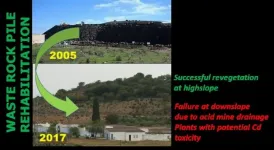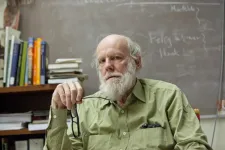Evaluating the rehabilitation of an old mine waste rock pile
2021-03-12
(Press-News.org) The Cabeza de los Gatos waste rock pile, left from mining activities in the town of Tharsis (Huelva), underwent a rehabilitation process consisting of remodelling the slope of the pile, applying liming materials and then a layer of soil. Finally, trees and shrubs typical of the area were planted and a hydroseeding with a mixture of shrub and herbaceous seeds was applied. Twelve years later, a study led by researchers from IRNAS-CSIC, in collaboration with Sabina Rossini Oliva, a researcher from the University of Seville and the Environment and Water Agency of Andalusia (AMAYA), has proven the effectiveness of this sort of rehabilitation.
"The results obtained show that the steps taken were successful. Now, twelve years later, woody vegetation covers the upper part of the rehabilitated area and provides a green visual landscape for the inhabitants of the village. Furthermore, it has been proved that the aerial part of the vegetation growing on this upper part does not present significant levels of potentially toxic trace elements," Rossini explained.
In contrast, experts point out that the lower part of the slope is almost devoid of vegetation. Moreover, some of the plants growing at the base of the slope, such as gum rockrose (Cistus ladanifer), have cadmium concentrations exceeding the maximum tolerable level for animals, meaning they represent a toxicity risk for livestock.
"Our view is that this anomaly stems from acidic drainage from the pile which has caused a sharp drop in soil pH at the bottom of the slope. This has increased the presence of potentially toxic trace elements and thus their accumulation in plant leaves. This adverse effect has manifested as lower vegetation cover," the University of Seville researcher added.
In light of the results obtained, an alternative technique is proposed for the rehabilitation of mine rock waste piles by classifying and selectively managing the mine waste. This technique consists of managing excavation waste and selecting it based on its geochemical properties; separating materials that may generate acid from those that do not. The non-acid-generating waste should then be placed on the outside of the waste rock pile as a protective layer to prevent water contamination. This reduces infiltration rates, seepage and the negative effect of acid drainage from the mine.
INFORMATION:
[Attachments] See images for this press release:

ELSE PRESS RELEASES FROM THIS DATE:
2021-03-12
People with high levels of emotional intelligence are less likely to be susceptible to 'fake news', according to research at the University of Strathclyde.
The study invited participants to read a series of news items on social media and to ascertain whether they were real or fictitious, briefly describing the reasons for their answers. They were also asked to complete a test to determine their levels of emotional intelligence (EQ or emotional quotient) and were asked a number of questions when considering the veracity of each news item.
Researchers found that those who identified the types of news correctly were most likely to score highly in the EQ tests. There was a similar correlation between correct identification and educational attainment.
The ...
2021-03-12
In asthma, the airways become hyperresponsive. Researchers from Uppsala University have found a new mechanism that contributes to, and explains, airway hyperresponsiveness. The results are published in the scientific journal Allergy.
Some 10 per cent of Sweden's population suffer from asthma. In asthmatics, the airways are hyperresponsive (overreactive) to various types of stimuli, such as cold air, physical exertion and chemicals. The airways become constricted, making breathing difficult.
To diagnose asthma, a "methacholine test" is commonly used to determine whether a person is showing signs of airway hyperresponsiveness. Methacholine binds to what are known as muscarinic receptors in the smooth muscle cells lining the inside ...
2021-03-12
The researchers say this is a big step in tackling smouldering peat fires, which are the largest fires on Earth. They ignite very easily, are notoriously difficult to put out, and release up to 100 times more carbon into the atmosphere than flaming fires, contributing to climate change.
The fires, known as 'zombie fires' for their ability to hide and smoulder underground and then reanimate as new flames days or weeks after the wildfire had been extinguished, are prevalent in regions like Southeast Asia, North America, and Siberia.
They are driven by the burning of soils rich in organic content like peat, which is a large natural reservoir of carbon. Worldwide, peat fires account for millions of tonnes of carbon released into the atmosphere each year.
Firefighters currently use millions ...
2021-03-12
A new model of aging takes into account not only genetics and environmental exposures but also the tiny changes that randomly arise at the cellular level.
University Professor Caleb Finch introduced the "Tripartite Phenotype of Aging" as a new conceptual model that addresses why lifespan varies so much, even among human identical twins who share the same genes. Only about 10 to 35 percent of longevity can be traced to genes inherited from our parents, Finch mentioned.
Finch authored the paper introducing the model with one of his former graduate students, Amin Haghani, who received his PhD in the Biology of Aging from the USC ...
2021-03-12
Researchers at Lund University in Sweden can now show that a new examination method identifies high-risk plaques in the blood vessels surrounding the heart, that cannot be seen solely with traditional angiograms. This type of plaque, rich in fat, could potentially cause recurring heart attacks in patients with heart disease. The study is published in the The Lancet.
"We have been working on this study for ten years. This creates a unique opportunity to treat plaques before they cause a heart attack", says David Erlinge, professor of cardiology at Lund University and Consultant in ...
2021-03-12
During 1995-2015, fullerene derivatives had been the dominating electron acceptors in organic solar cells (OSCs) owing to their performance superior to other acceptors. However, the drawbacks of fullerenes, such as weak visible absorption, limited tunability of electronic properties and morphological instability, restrict further development of OSCs toward higher efficiencies and practical applications. Therefore, the development of new acceptors beyond fullerenes is urgent in the field of OSCs.
Professor Zhan Xiaowei from the College of Engineering at Peking University is one of the pioneers engaging in development of nonfullerene acceptors in the world. ...
2021-03-12
University of Otago researchers have discovered one of the reasons why more than 50 per cent of people with type 2 diabetes die from heart disease.
And perhaps more significantly, they have found how to treat it.
Associate Professor Rajesh Katare, of the Department of Physiology, says it has been known that stem cells in the heart of diabetic patients are impaired. While stem cell therapy has proved effective in treating heart disease, it is not the case in diabetic hearts.
It has not been known why; until now.
It comes down to tiny molecules called microRNA which control gene expression.
"Based on the results of laboratory testing, ...
2021-03-12
New bioarchaeological research shows malaria has threatened human communities for more than 7000 years, earlier than when the onset of farming was thought to have sparked its devastating arrival.
Lead author Dr Melandri Vlok from the Department of Anatomy, University of Otago, says this ground-breaking research, published today in Scientific Reports, changes the entire understanding of the relationship humans have had with malaria, still one of the deadliest diseases in the world.
"Until now we've believed malaria became a global threat to humans when we turned to farming, but our research shows in at least Southeast Asia this disease was a threat to human groups well before that.
"This research providing a new cornerstone of malaria's evolution with humans is a great achievement ...
2021-03-12
When people think of sea level rise, they usually think of coastal erosion. However, recent computer modeling studies indicate that coastal wastewater infrastructure, which includes sewer lines and cesspools, is likely to flood with groundwater as sea-level rises.
A new study, published by University of Hawai'i (UH) at Mānoa earth scientists, is the first to provide direct evidence that tidally-driven groundwater inundation of wastewater infrastructure is occurring today in urban Honolulu, Hawai'i. The study shows that higher ocean water levels ...
2021-03-12
Light-emitting diodes (LEDs) have revolutionized the displays industry. LEDs use electric current to produce visible light without the excess heat found in traditional light bulbs, a glow called electroluminescence. This breakthrough led to the eye-popping, high-definition viewing experience we've come to expect from our screens. Now, a group of physicists and chemists have developed a new type of LED that utilizes spintronics without needing a magnetic field, magnetic materials or cryogenic temperatures; a "quantum leap" that could take displays to the next level.
"The companies that make LEDs or TV and computer displays don't want to deal with magnetic fields and magnetic materials. It's heavy ...
LAST 30 PRESS RELEASES:
[Press-News.org] Evaluating the rehabilitation of an old mine waste rock pile




